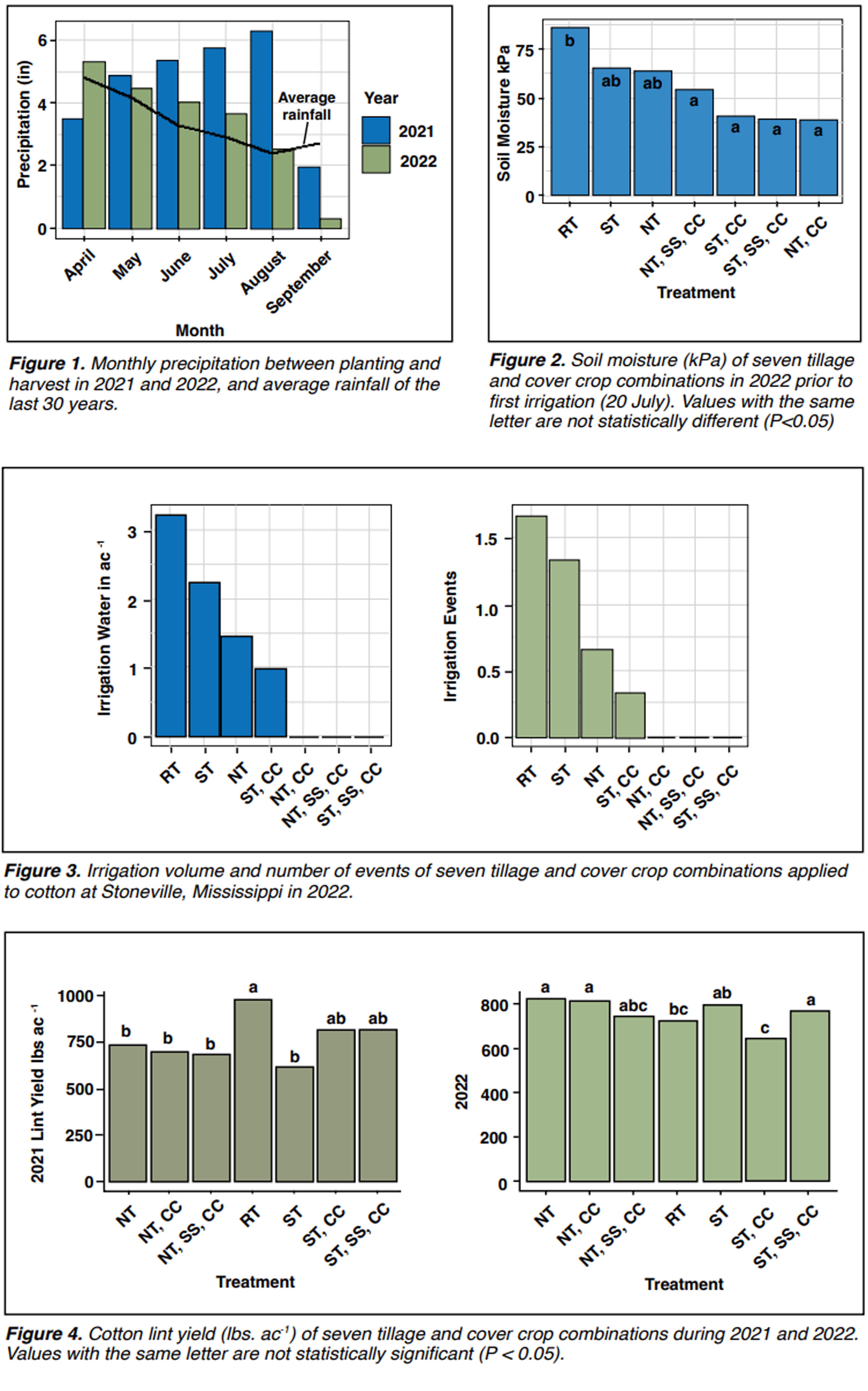Research Project
Cover Cropping in Cotton Can Save Irrigation Water in Dry Years
Investigators: Carson Roberts, Drew Gholson, Martin Locke, Dave Spencer, Whitney Crow, and Brian Pieralisi, and Nicolas E. Quintana Ashwell
Funding Agency: Sponsored partially by Cotton Incorporated under project 21-863
Date: 2022
Project Summary
Introduction
Cover crops have been touted as a "miracle cure" for most soil and environmental issues in agriculture, but after years of research there remain only a handful of proven benefits. One of those is the conservation of water, specifically on arid and semi-arid dryland. Water saving in that setting have translated to improved yields. Often, however, ample water resources mask those benefits making the cover cropping expense unjustifiable in areas with irrigation or high precipitation. The Mississippi Delta has both. It is likely that the improved infiltration and water holding capacity in a cover crop system could translate to less irrigation water use, but in the past, it has been very difficult to quantify. This study was developed to investigate how conservation tillage and cover crop systems influence lint yield and irrigation water use efficiency. It is hypothesized that water use can be reduced, and yield can be maintained or improved under conservation systems in the Mid-South.
Materials and Methods
A study is being conducted in Stoneville, MS, from 2021 to 2023 on a Dubbs silt loam (finesilty, mixed, active, thermic Typic Hapludalfs). Study treatments include reduced tillage with subsoil (RT), strip tillage (ST), strip tillage with cover crops (ST,CC), strip tillage with cover crops and subsoil (ST,CC,SS), no tillage (NT), no tillage with cover crops (NT,CC), and no tillage with cover crops and minimal surface disturbance subsoil (NT,CC,SS). Cover crops in all treatments consist of a 50/50% blend of hairy vetch and cereal rye planted at 60 lbs/ acre. This study is organized as a randomized complete block design with three replications. Plots consist of eight 40" rows that are 500' in length.
Cover crop treatments were terminated two weeks prior to planting. After being terminated, ST plots were tilled using a strip tillage implement (Figure 1). The variety Deltapine® 2012 BX3 was planted, routine fertility, pesticide, and PGR applications were made. Watermark® soil moisture sensors were installed, and irrigation was triggered at -90 kPa. Data were analyzed in R studio using the lmer function in the lme4 package, and means were separated using unrestricted LSD.
Results and Discussion
Excessive rainfall occurred during the 2021 growing season (Figure 1). This resulted in the irrigation of only one RT plot after reaching the -90 kPa irrigation trigger, so no assumptions were made regarding irrigation water use efficiency in 2021. Precipitation in 2022 followed more normal patterns.
Soil moisture in 2022 differed across the treatments with the RT treatment being significantly drier than any of the treatments where winter cover crops were grown (Figure 2).
All cover crop treatments contained more soil moisture when contrasted against winter fallow systems. This led to more irrigation water used in the winter fallow systems (Figure 3). It also caused the RT system to be irrigated more frequently than most of the other systems. When tilled and weathered, soils can form a crusty or platy structure that inhibits infiltration. That poor structure formation is likely to blame for the increase irrigation water use when the soil is not protected during the winter months.
Lint yields in 2021 were greatest where RT treatments were implemented and were comparable to ST,CC,SS and ST,CC treatments (Figure 4). The differences in yield are likely caused by other factors than water use since precipitation throughout the growing season provided ample water for the crop needs. In 2022, results were mixed with the yield of most treatments remaining similar to one-another. Although the NT,CC, NT,SS,CC, and ST,SS,CC treatments remained unirrigated, yield reductions did not occur.
Conclusion
No water-related benefits were realized in 2021 where precipitation was heavy and timely. In drier years like 2022 where irrigation was common, treatments where cover crops were sown needed little to no irrigation, and yield did not suffer. Further investigation at this site is needed to gain a deeper understanding of the results seen here.
Project Photos

- Crop Type:
- Cotton
- Topic:
- Cover Crops
- Tillage
- Soil
Find Research
By Crop Type
By Topic
Contact NCAAR
General Information
Kaye Sullivan
vfs23@msstate.edu
662.390.8510
F:662.390.8501
Showcase Demo
Drew Gholson, Coordinator
drew.gholson@msstate.edu
662.390.8505
Himmy Lo
himmy.lo@msstate.edu
662.390.8509

